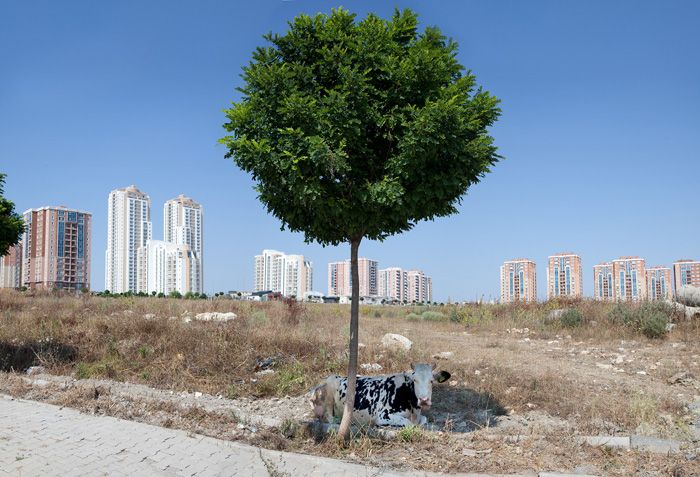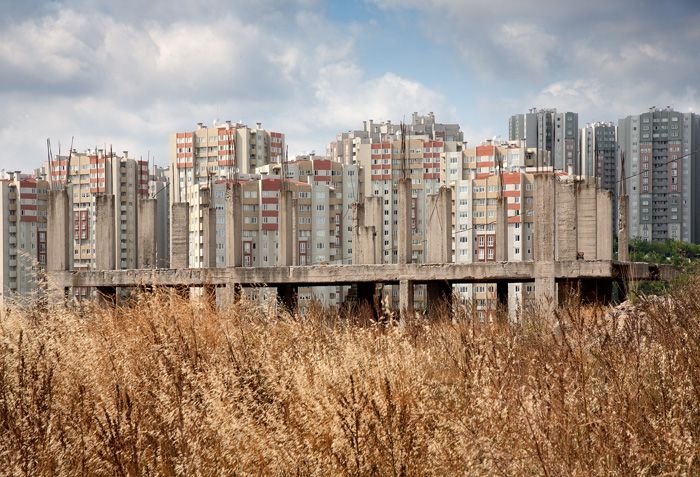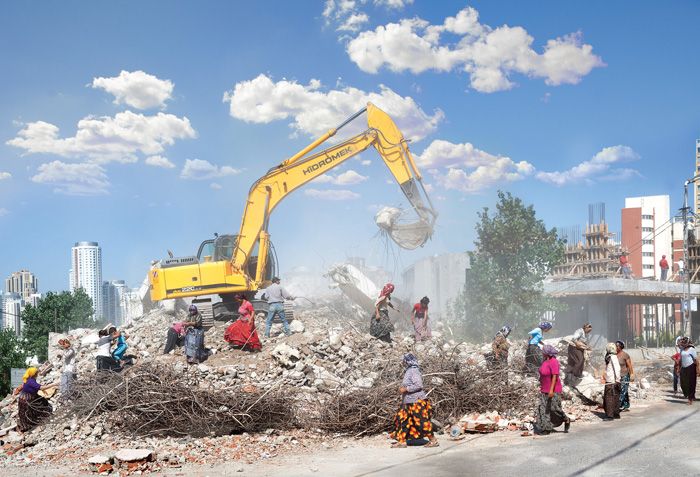blog
Interview with photographer Mark Slankard
F-Stop Magazine: How did you first become involved in photography and what led you to working in this medium?
Mark Slankard: I was studying psychology at Indiana University. I’d had a camera for a while, so during my final semester I took a photography course and was really inspired. Instead of applying to graduate schools in psychology as I had planned, I set up a black and white darkroom in my parents’ utility room and carried my camera around with me everywhere. In those days I was primarily influenced by the work of Robert Frank and Henri Cartier-Bresson. I was doing a lot of street photography, looking for candid moments or ironic scenes. I loved the way photographs transformed and solidified the flux in front of my camera’s lens. I worked at a couple of camera stores and went on to take some additional photography classes. After three years I was off to pursue my Master of Fine Arts degree at Ohio University.
F-Stop: You’re photography project ‘Toplu: Landscapes of New Turkish Suburbia’ shows creative juxtaposition of construction and landscapes. How did your interest in this begin and can you discuss your creative process for making these images?
MS: Graduate school challenges you to confront your assumptions and habits. One technical change was that I switched from a small 35mm camera to a view camera. This completely changed my working method – working with individual sheets of film, being fixed on a tripod, and composing upside-down, for example. As anyone who’s used a large format camera knows, it slows you down. The process became more ponderous as I spent more time with each image. I began to look at the landscapes that I had grown up in, and how they were shifting. I was still interested in making images that had some of the dynamism of my street photography. I found that by creating contrasts I could create somewhat wry commentary on what is arguably a pretty banal subject – Midwestern American suburban houses.
Though I use primarily digital cameras now, I developed my compositional sense using the view camera. Landscape, and specifically the built residential landscape, became my main subject. I was initially attracted by the visual effects of the repetitions of pitched roofs, verdant grass and clear blue skies. However, as the work developed, it evolved into a philosophical inquiry into delineations and borders – how residents and planners defined their spaces against the perceived chaos of the outside world.
F-Stop: You’ve said you visit Turkey regularly. Do you need to spend a long time in a city or place to appreciate its culture and to be able to capture its qualities in a photograph? What changes have you noticed over the years either of the cities or your photography of them?
MS: My wife is from Turkey, so we visit her family every summer. Initially I really only took snapshots. I found my attempts at making art there were either generic, or if it contained any commentary, it came across as naïve or exploitative of a culture that I had limited familiarity with.
As is increasingly the case with the Turkish middle class, my wife’s family lives outside of the city centres in new large-scale condominium complexes. These developments require large swaths of land. Often, this land has already been settled with rural shanty structures. So you have large clusters of modern high-rises situated right up against much more modest communities. Many contain their own amenities such as shops, restaurants, and swimming pools, and the more expensive ones are usually guarded and gated off from the surrounding communities. I gradually came to recognize this as an exaggerated version of what I had been dealing with in my previous work. Most of the development in Istanbul is so rapid that I witnessed landscape transformed from year to year. Other areas develop much more slowly and sometimes ceased before they are completed. What were peripheral developments on the outskirts had become their own nodal centres, while others remain ghost towns.
It wasn’t until my fifth year visiting that everything fell into place and allowed me to make serious work. First, my understanding of the place had matured. Secondly, prosumer full-frame digital cameras were entering the market. This allowed me the image quality I needed, but was much more practical than a view camera while traveling. And finally, and perhaps most importantly, I had worked up the nerve to drive in Istanbul. So I rented a car and drove like a Turk. This allowed me to explore in a way that wasn’t practical with public transportation.
F-Stop: How do you make a project about a specific city like Ankara or Istanbul relatable to someone elsewhere in the world? Is that something you think about when putting a project together?
MS: I hope the photographs work on multiple levels. Yes, there is the specificity of Ankara or Istanbul, but thanks to globalization the themes are familiar. The binaries between wealth and poverty, urban and rural, eastern and western, order and chaos, old and new are everywhere. The developing landscape in the Turkish suburbs simply offers many instances of these stark contrasts in side-by-side comparisons. So, yes, I definitely intend the work to also be relevant to someone who has no connection to Turkey whatsoever.
F-Stop: Your panoramic image of Istanbul shows the full aspect of urban living spaces contrasted with green landscape. What was your creative process behind this photo specifically?
MS: During the first year I was photographing I came across a scene that worked best as a panoramic image (Gecekondu and Toplu Konut, Ümraniye, Istanbul, 2008). So I made three images from the same position, one of the left side, one of the middle, and one of the right, which I later stitched together using Photoshop. I later realized that I could increase the resolution and detail of all of my images using this method. So I began photographing each scene in rows or grids. Most of my work from 2009 on was created from multiple images merged in this way. This year I also photographed using a Gigapan, a tripod-mounted robot used to photograph grids in this manner. I am currently in the process of editing the work. Some of are created from more than 70 individual images. I’m excited to see what the effect of this extra fidelity brings to the work.
F-Stop: Do you have a favourite image from your project? If so, which one and why is it the image that speaks to you most?
MS: One image that really sticks with me is Structure, Ümraniye, Istanbul. I made it in 2008, my first year of the project. I love the way the long lens causes the vertical lines in the foreground and background to intermingle, and the way the buildings appear to go on forever. The structure in the foreground seems as though it was abandoned during its construction. It becomes difficult to tell what’s coming, and what’s going. But the real reason I love that image is the beautiful light. Like most photographers, I’m a sucker for light. It just wins me over.
F-Stop: You recently took part in the group exhibition ‘Homegrown – Northeast Ohio Photographers’ at the Cleveland Print Room Gallery. Do you enjoy the experience of being part of an exhibition and sharing your photos with an audience in this way?
MS: Homegrown was a really fantastic show. It was the second exhibition in a new dedicated photography gallery / community darkroom in Cleveland. It was a group show that featured about twenty-five local photographers. There haven’t been a lot of shows like that here since I’ve lived here. So the opening was a huge party with the entire photo community, and most of the broader art community. Most artists were represented by a single piece, sometimes two.
While the show was a great experience, I am artistically most rewarded by exhibitions that feature multiple pieces from individual artists or that are developed around a theme. For instance, I’ve recently had several two and three-person exhibitions developed around themes of landscape that offer a more depth of my work, as well as its relevance to other artists working with similar ideas. Last year my work was part of a three-person exhibition that included the Great Bill Owens, one of my biggest influences. That was an enormous honour.
F-Stop: What do you hope people see, feel or perhaps learn when they look at your photographs? What feedback or reactions have you received?
MS: I hope my work strikes a chord with the audience. There should be some sort of recognition of their own experience. I want my work to contain both specificity and metaphor, while still leaving enough open to interpretation that the viewer can mentally finish the work, or make their own connections.
One of my favourite specific reactions I get from time to time is from Turkish audiences. Often they are in disbelief of the images. Although it is something that many of them have witnessed first hand, they are surprised when they see it fixed in an image.
F-Stop: Is Cleveland a supportive city for photographers in encouraging exhibitions and development of talent?
MS: When I came to Cleveland in 2008, I was really excited about the art scene. But I have to admit that most of the best galleries in town tended to stay away from contemporary photography. However there have been a lot of really exciting developments in the last couple of years. Probably the biggest news is the opening of the Transformer Station, a world-class dedicated photography / contemporary art gallery created by Cleveland Museum of Art and Fred and Laura Bidwell, major photography collectors from nearby Akron, Ohio. Barbara Tannenbaum became the new curator of photography at the Cleveland Museum of Art. She is very interested in contemporary photography and cultivating local photographers. She is fantastic about reaching out to local photography students. The new Cleveland Print Room is one of two local businesses dedicated to film-based photography. The other galleries have since become more inclusive of photo-based media. So I no longer get to complain that art photography is underrepresented in Cleveland, Ohio. It is headed towards dominance.
F-Stop: What photographers or other artists inspire you?
MS: As I mentioned earlier, I was initially turned on to photography by the great street photographers, Bresson, Frank, André Kertesz, as well as the FSA photographers. In college, my professor showed us “Blood Ties”, a documentary about Sally Mann. That film was hugely influential, and inspired me to pursue photography in a serious way. Later I was looking to the New Topographics movement to understand issues surrounding photography and landscape. At the same time I became aware of the wave of photographers dealing with domestic themes, such as Eggleston, Gregory Crewdson, Tina Barney, Joel Sternfeld, Nic Nicosia, Larry Sultan, Laurie Simmons and Cindy Sherman. Though it may not be evident in this project, I also enjoy artists who use experimentation and process as an important component of their work, or that use photography in surprising ways like Vic Muniz, Taryn Simon, John Hilliard, Boyd Webb, Adam Fuss, Steven Pippin, and Jordan Tate.
F-Stop: What has been the best career advice you’ve received? What advice do you have for someone with an active interest in photography?
MS: I’ve had the good fortune of working with many terrific mentors, and I’ve received more than my fair share of good advice. So it’s difficult to choose one bit of career advice to summarize everything. But the one I’ve decided to share is concise, and probably familiar to anyone who studied photography with James Nakagawa at Indiana University. Anytime he saw promise in work he would end his feedback with the succinct directive, “PUSH IT!” I’ve used this advice many times myself to my own students.
My advice is to find a subject that excites you. Then give yourself over to it. Explore it, read about it, ponder it, and let the subject guide you. Make work, lots of it. Edit judiciously. Seek feedback and process it so you can incorporate your new understanding back into your work.
For more of Mark Slankard’s work: www.markslankard.com
Location: Online Type: Interview
One response to “Interview with photographer Mark Slankard”
Leave a Reply
Events by Location
Post Categories
Tags
- Abstract
- Alternative process
- Architecture
- Artist Talk
- Biennial
- Black and White
- Book Fair
- Car culture
- charity
- Childhood
- Children
- Cities
- Collaboration
- Cyanotype
- Documentary
- environment
- Event
- Exhibition
- Family
- Fashion
- Festival
- Film Review
- Food
- Friendship
- FStop20th
- Gun Culture
- Italy
- journal
- Landscapes
- Lecture
- love
- Masculinity
- Mental Health
- Museums
- Music
- Nature
- Night
- photomontage
- Podcast
- Portraits
- Prairies
- River
- Still Life
- Street Photography
- Tourism
- UFO
- Wales
- Water
- Zine







[…] to see that not only did they include several of my images in their Cities group exhibition and an interview, but they also used my image for the magazine cover (above). Please check it out. I give a few […]